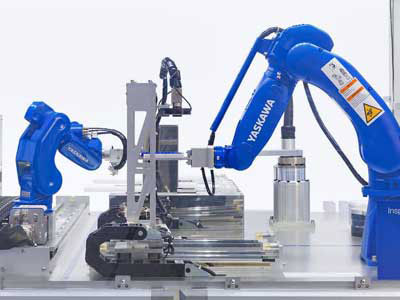Key Takeaway
Industrial robots are automated machines designed to perform repetitive tasks in manufacturing and industrial applications. They can weld, assemble, paint, and inspect products with high precision and efficiency. These robots are equipped with sensors and control systems, allowing them to adapt to different tasks and environments. By automating routine processes, industrial robots increase productivity and reduce human error. They also enhance workplace safety by handling hazardous tasks. Industrial robots are essential in modern manufacturing, providing flexibility and consistency in production lines. Their use leads to higher quality products and lower production costs.
Definition and Overview
Industrial robots are programmable machines designed to execute complex tasks with precision, speed, and consistency. In modern manufacturing, they significantly enhance efficiency and productivity while minimizing human error. Equipped with advanced sensors, actuators, and controllers, these robots can perform a variety of tasks, from simple pick-and-place operations to intricate assembly processes. Their ability to work tirelessly and accurately makes them invaluable tools in the industrial sector, ensuring high-quality production and operational excellence.

Historical Background
Industrial robots have a rich history dating back to the mid-20th century, marked by pioneering efforts to mechanize repetitive tasks within industrial settings. These early prototypes, though cumbersome by today’s standards, laid the groundwork for what would become a revolution in manufacturing. Over the decades, relentless advancements in robotics technology have catapulted these machines from basic, single-function tools to versatile, adaptable systems capable of handling a myriad of production demands.
Today’s industrial robots are not merely mechanical arms but sophisticated entities designed to operate autonomously or with minimal human oversight. They are powered by advanced processors that meticulously execute programmed instructions, ensuring precision and efficiency across various manufacturing processes. Equipped with cutting-edge sensors and vision systems, these robots can perceive their surroundings in real-time, making dynamic adjustments to optimize performance and maintain safety in bustling factory environments.
Key Features and Components
Autonomous Operation and Advanced Programming
One of the defining characteristics of modern industrial robots is their capability for autonomous operation. These robots are programmed to perform complex tasks with minimal intervention, leveraging sophisticated algorithms and programming languages tailored to specific industrial needs. This autonomy not only enhances productivity but also reduces human error, making manufacturing processes more reliable and cost-effective.
Mechanical Design and Sensor Integration
At the heart of an industrial robot lies its mechanical structure, typically comprising articulated arms fitted with joints and grippers. These components enable precise movements and versatile functionality, crucial for handling diverse tasks on the factory floor. Integrated sensors play a pivotal role by providing real-time feedback on position, force, and environmental conditions, allowing robots to adjust their actions dynamically. This integration of mechanical prowess with sensory acuity ensures that robots operate safely alongside human workers and other machinery, promoting a harmonious workflow in industrial settings.
Types and Classifications
Industrial robots are specialized machines designed to perform tasks traditionally carried out by humans, enhancing efficiency and precision across various industries. Understanding the types and classifications helps in deploying them effectively.
Articulated Robots: These robots mimic the flexibility of human arms with multiple rotary joints, making them ideal for intricate tasks such as assembly and welding in automotive and electronics industries. Their ability to reach around obstacles with precision makes them invaluable in manufacturing processes requiring dexterity.
SCARA Robots: Known as Selective Compliance Assembly Robot Arms, SCARA robots excel in high-speed operations like pick-and-place tasks. Their design ensures quick, repetitive movements, making them perfect for applications demanding rapid assembly or packaging, such as in consumer electronics or food packaging lines.
Cartesian Robots: These robots move along Cartesian coordinates (X, Y, Z axes), providing precise linear motion essential for tasks like 3D printing and CNC machining. Their straightforward movement pattern makes them reliable for applications requiring exact positioning and repeatability, crucial in industries where precision is paramount.
Applications in Modern Industries
Industrial robots have revolutionized manufacturing across diverse sectors, driving efficiency and quality in production processes.
Automotive Manufacturing: In automotive assembly lines, robots handle welding, painting, and assembly tasks with unmatched speed and accuracy. This automation not only accelerates production cycles but also ensures consistent quality in vehicle manufacturing, meeting stringent industry standards.
Electronics Manufacturing: Robots play a crucial role in electronics manufacturing by delicately handling components such as microchips and circuit boards. Their precise placement capabilities ensure that electronic devices function reliably, meeting the demands of consumers worldwide for high-tech gadgets.
Pharmaceuticals and Food Processing: In pharmaceuticals, robots facilitate sterile environments and precise handling of medicines and medical supplies, enhancing safety and efficiency in drug production. Similarly, in food processing, robots automate tasks such as packaging and sorting, ensuring food safety and compliance with hygiene standards while boosting production output.
Logistics and Supply Chain Management: Industrial robots are increasingly employed in logistics for material handling and warehouse operations. They streamline order fulfillment processes, optimize inventory management, and facilitate just-in-time supply chain strategies, thereby improving operational efficiency and reducing costs for businesses.
Industrial robots continue to evolve, integrating advanced technologies like artificial intelligence and machine learning to further enhance their capabilities. As automation becomes more pervasive, understanding these robots’ applications and capabilities is essential for engineers and professionals entering the industrial sector. Embracing robotic technology not only improves productivity but also ensures competitiveness in a global market driven by innovation and efficiency.
Conclusion
In conclusion, understanding industrial robots is crucial for engineers in manufacturing. These machines enhance efficiency, productivity, and safety, reshaping industries. As automation evolves, industrial robots will become even more vital in driving economic growth and technological advancement globally. By following these guidelines, the content ensures clarity and engagement, catering to both newcomers and experienced professionals in industrial automation.
